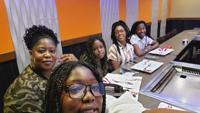(CNN) — The James Webb Space Telescope has captured a stunning new image of the closest star-forming region to Earth, located 390 light-years away.
The release of the image marks the first anniversary since the space observatory began observing the universe.
Webb’s detailed closeup showcases the chaos of the Rho Ophiuchi cloud complex, where crisscrossing jets from young sunlike stars hit interstellar gas and cause it to glow.
Some of the stars are wreathed in shadows that hint at circumstellar disks, the swirling rings of gas and dust where planets are born.
The cloud complex contains 50 stars similar in mass to our sun, which means these future planetary systems may resemble what our own solar system looked like in the very beginning.
The darkest parts of the image are where stars that are still forming are cocooned in dust, while the jets of molecular hydrogen make bold splashes in red.
“Webb’s image of Rho Ophiuchi allows us to witness a very brief period in the stellar lifecycle with new clarity. Our own Sun experienced a phase like this, long ago, and now we have the technology to see the beginning of another’s star’s story,” said Klaus Pontoppidan, Webb project scientist at the Space Telescope Science Institute in Baltimore, Maryland and research scientist at NASA, in a statement.
The most powerful telescope ever sent to space, Webb , and NASA shared its first set of scintillating images on July 12, 2022.
The space observatory’s included distant galaxies, the atmospheric composition of an exoplanet and a stellar nursery, where stars are born.
“In just one year, the James Webb Space Telescope has transformed humanity’s view of the cosmos, peering into dust clouds and seeing light from faraway corners of the universe for the very first time. Every new image is a new discovery, empowering scientists around the globe to ask and answer questions they once could never dream of,” said NASA Administrator Bill Nelson in a statement.
“Webb is an investment in American innovation but also a scientific feat made possible with NASA’s international partners that share a can-do spirit to push the boundaries of what is known to be possible. Thousands of engineers, scientists, and leaders poured their life’s passion into this mission, and their efforts will continue to improve our understanding of the origins of the universe – and our place in it.”
Unveiling the secrets of the universe
Webb captures the universe in infrared light, which is invisible to the human eye. The telescope cuts through obscuring gas and dust across the cosmos to reveal previously unseen features and showcase other celestial details with advanced precision.
While the initial images provided a sample of Webb’s capabilities, the telescope’s first year of cosmic observations has been nothing short of awe-inspiring, and the discoveries it has enabled have both encouraged and surprised astronomers.
“On its first anniversary, the James Webb Space Telescope has already delivered upon its promise to unfold the universe, gifting humanity with a breathtaking treasure trove of images and science that will last for decades,” said Nicola Fox, associate administrator of NASA’s Science Mission Directorate, in a statement.
“An engineering marvel built by the world’s leading scientists and engineers, Webb has given us a more intricate understanding of galaxies, stars, and the atmospheres of planets outside of our solar system than ever before, laying the groundwork for NASA to lead the world in a new era of scientific discovery and the search for habitable worlds.”
One of Webb’s greatest strengths is capturing the . The observatory can essentially as it studies cosmic objects that formed shortly after the beginning of the universe.
Given the vastness of the universe, studying its earliest days is like looking back in time.  is still traveling across the universe to reach Earth, so the farthest reaches of the universe visible to scientists is light from the past.
In its first year alone, the telescope has already identified some of the , which formed just a few hundred million years after the big bang.
Studying these galaxies, which have been beyond the observational reach of other telescopes, can help astronomers piece together more details about the early days of the universe — including how the and stars came to be.
The telescope has observed a broad range of galaxies and other celestial objects, creating a catalog of cosmic phenomena that could change the way scientists understand the universe.
Webb has witnessed an , identified , captured , spied and spotted . The telescope has also flexed its and demonstrated its ability to across the universe.
“The breadth of science Webb is capable of exploring really becomes clear now, when we have a full year’s worth of data from targets across the sky,” said Eric Smith, associate director for research in the Astrophysics Division at NASA Headquarters and Webb program scientist, in a statement.
“Webb’s first year of science has not only taught us new things about our universe, but it has revealed the capabilities of the telescope to be greater than our expectations, meaning future discoveries will be even more amazing.”
In addition to unveiling previously hidden aspects of the universe and distant galaxies, astronomers also used Webb to observe more well-known features in new ways.
The telescope captured both and of the Pillars of Creation as well as spying . Both have served as the targets of other telescopes like the Hubble Space Telescope in the past.
Webb has also conducted observations a little closer to home, capturing views of , , and in an eye-opening new light. The telescope also glimpsed a and clouds on the ringed planet’s moon .
While Webb has the ability to , the observatory also .
And it’s just the beginning. The telescope’s team at NASA estimates that Webb will be able to spend the next two decades revealing the invisible side of the universe and leading the way to discoveries both anticipated and unknown.
“With a year of science under our belts, we know exactly how powerful this telescope is, and have delivered a year of spectacular data and discoveries,” said Webb Senior Project Scientist Jane Rigby of NASA’s Goddard Space Flight Center in Greenbelt, Maryland, in a statement. “We’ve selected an — that builds on everything we’ve learned so far. Webb’s science mission is just getting started — there’s so much more to come.”
The-CNN-Wire
™ & © 2023 Cable News Network, Inc., a Warner Bros. Discovery Company. All rights reserved.














